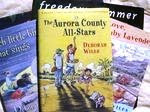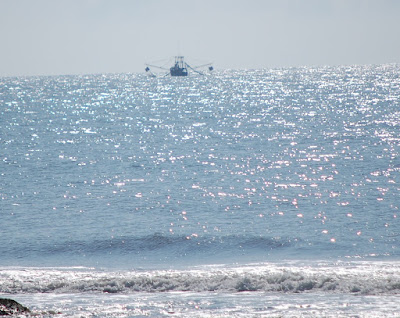 "Story is story," said Nancy Johnson. So I signed up and stayed, and in this class HANG THE MOON was born. It started as an assignment Nancy gave us to list (and you wonder why I love listing so) -- list places we had lived, people we had known in those places, and I don't remember the third thing anymore.
"Story is story," said Nancy Johnson. So I signed up and stayed, and in this class HANG THE MOON was born. It started as an assignment Nancy gave us to list (and you wonder why I love listing so) -- list places we had lived, people we had known in those places, and I don't remember the third thing anymore.Three columns. Then, circle one thing in each column and write a story that ties them together, a made-up story. As I did my listing, a place called to me -- Mississippi -- and a girl jumped out at me... a woman, actually, who was angry. She had a friend who was a self-proclaimed psychic living in an Airstream trailer by the side of the road. She had a boyfriend who did her wrong. She had recently pulled his sorry butt out of the lake and saved him from drowning. She thinks she may be sorry she did this.
What captivated me about this story was two things. First, its voice -- I had no idea who this young woman was, but she had my full attention. She was amazing! The things that came out of her mouth! She was unlike anyone I'd ever invented -- she had pizazz and life and needs and faults. She pushed. She lied. She took my breath away and I loved her with all my heart.
The second thing I loved was Story. This piece was my first glimpse into writing a real story. I still had no idea, really, about plot. I had setting knocked -- WHEN I WAS YOUNG IN THE MOUNTAINS was my go-to book for setting and I had written so many stories (all rejected, although some came close) with that feeling of place. "Quiet books," I learned to call them.
But this! This new exciting thing had the makings of a story, a real story, and I could tell it did. I just had no idea what to do with it next. I had no idea how to frame a story with beginning-middle-end, and what was all that stuff in between supposed to be?
I tucked this little story away -- it was a character sketch, really. But this girl would not shut up. She was insistent. She wanted her story told. I'd wake up thinking about her, I'd fall asleep thinking about her.. and so I got out my notebook and began searching for her.
I wrote page after page of who she might be, all the while working on nice, pretty, slice-of-life stories for children that got rejected and rejected by publishers. Eventually, as I took another class from Nancy (this one a poetry class that birthed what would become LOVE, RUBY LAVENDER), as I read and read children's literature and discovered that my heroine in my Mississippi story would fit right into the world of children's literature if I could only figure out how to help her do it, I began to write her story.
And that's what I'm about to go back to, on October 1. I could write a book on where this story has been and what happened to my feisty heroine. I made her thirteen. I named her Birdie. I gave her a cousin named Margaret. I gave her a mother named Lily Pearl who lives in an Airstream trailer on the side of the road and calls herself Madame Pearls of Wisdom. I gave her an entire family of eccentrics that I also fell in love with. I built a world for Birdie and her thirteen-year-old cousin Margaret to inhabit -- the rich, full, amazing world of 1966 Mississippi.
And then I got stuck. I'm going to detail how I got stuck, unstuck, stuck again, and the convolutions of publishing and bringing this story to life, as I begin again to write for publication what has now become Book Two of the Sixties Trilogy.
My most fervent hope is that I am writer enough to take this story in hand today and tell it. It was larger than my talent -- and my skills -- when I discovered it. Birdie came screaming off the page in 1995, running for me full tilt. She steamrolled right over me. I ran behind her for years and years. Now, in 2009 -- fourteen years later -- maybe I am running right alongside her. I hope so.
So. This morning I made my customary oatmeal -- I haven't eaten breakfast in a long time, and I need to call in all my good living and writing habits. I am doing a read-through of the novel in its various incarnations ("various" is an understatement). I've hauled out the notebooks I've kept over the years that detail this story. I'm going back in time -- my time, and Birdie's.
Years ago, writer friends and I had a running discussion about just whose story this was -- Birdie's or Margaret's. And you know... I don't know. I'll talk about that, too. I'll talk about how the story peters off before it's half through. I'll detail my progress, or lack thereof.
Putting it all here will help me keep going... that's what I hope. And I hope you'll be working on your work-in-progress as well. I hope you'll comment, if you are (or aren't). I'm looking forward to the dialogue about the creative process and just-plain-skill we're hoping to hone as we work forward.
Each book creates its own challenges, its own questions, and its own solutions. Each project demands its own time. I have learned this. I hope, for HANG THE MOON, its time is now.











































